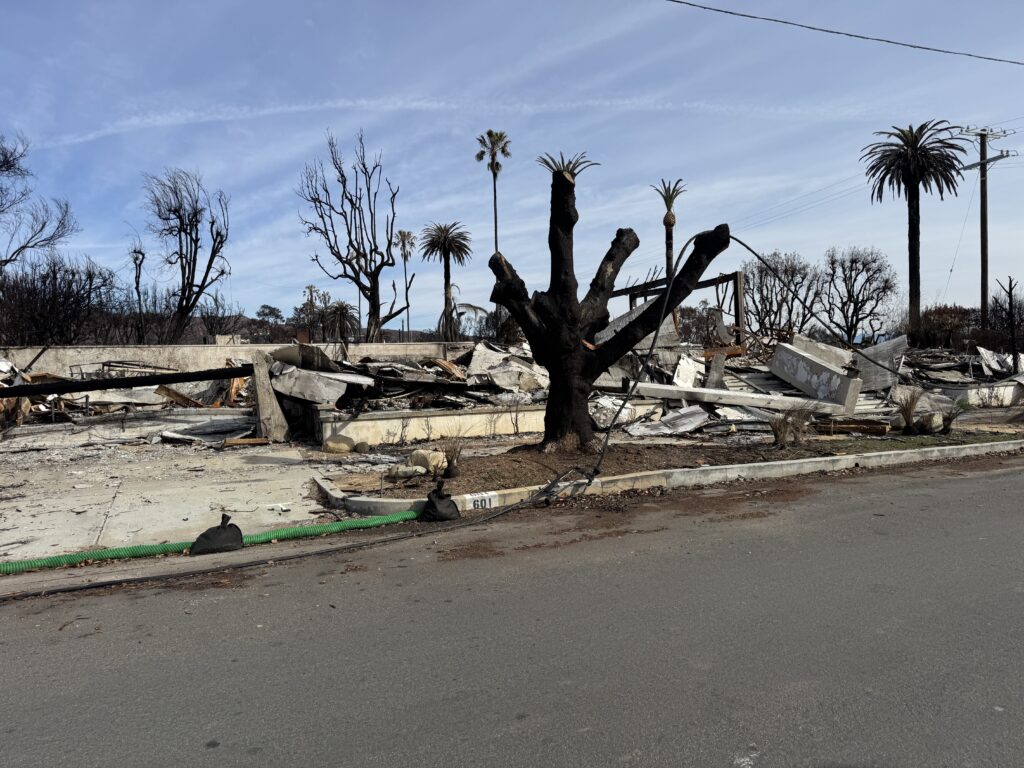
People who have “complex” lots that include basements, swimming pools and intensive stone and deck work are Opting-out on debris removal by the Army Corps of Engineers.
Many people who lost their homes in the Palisades Fire, such as Mark Tabit, looked at both options for debris removal. He discovered that the Army Corps of Engineers does not take out driveways, patios, swimming pools, or other hardscaping, so he decided to Opt-out.
But Opting-out, and what has been a simple process in other disaster areas, turned into a two-month ordeal for private contractors and their clients.
March 4, CTN received an email from a Huntington Palisades resident who had wanted to Opt-out for debris removal because they felt their property was complex. They learned that even after the Army Corps did an initial cleaning, the resident would still have to hire a private company to finish it.
They opted-out and thought they were set, but the contractor wrote that after weeks of negotiating with the County that “Despite our strict adherence to all pertinent city and county regulations, it is evident that the city, county, and Waste Management are hindering private homeowners from managing their own lot clearances.”
The company said that they had complied with all required guidelines but still faced roadblocks. “We have clients who have checked all the boxes and still can’t clear their lots to move forward. Our clients have received debris removal permits, Opted-out, have a full comprehensive survey by a CIH, phase I completed, and are even going above the Army Corp guidelines with soil testing which we now understand the Army Corp is not doing.”
The company finally “gave up” and pulled out of the Palisades, leaving some residents in the Huntington without a private contractor for debris removal.
Now, almost two months after the fire, there are finally private companies finishing the first debris removal.
Tabit told CTN that there has been a lot of problems with the opt-out process and put the editor in touch with Renee Houston a consultant that works with private contractors.
Houston came to the Palisades on January 12. It seemed that the County/City had no process in place for private contractors. When she went to the Pavilion to inquire, she was passed from person to person, but nobody had answers. Ultimately she went to the Public Works office to inquire about technical difficulties as well as process complexities.
It seemed that residents were being pushed toward the Opt-in process with the Army Corps because it was easier. “It was very clear what the Opt-in process was, but the Opt-out process was not in place.”
She said that the Federal government, through the Army Corps of Engineers, specializes in disasters and are efficient when a disaster strikes.
It would take more than two months for the County get a process in place so that private contractors could start debris removal for those who wanted to Opt-out.
Initially private contractors had to fill out a form by Epic L.A., through public works. But the form was not online, and everything had to be submitted via paper.
Then the form was put online, and if a contractor started the form and did not complete it, it would not save, and the entire form needed to be filled out again. “It kicked you out if you did not fill in everything,” Houston said.
She worked with other contractors experiencing the same problem: the system was not working. When she went to the County Public Works, no one seemed to know what was going on. After working with the technical team that saw the problems and the point of contact on the process of the permit, it was clear that changes were being made on a continued basis.
Oran Belillti, of Ortam Construction, has been working in the Palisades for the past decade. He also acknowledged that there were initial difficulties. “It has been a topsy turvy process,” he said. “There were issues in pulling permits.”
Houston said the required licensing changed from day-to-day, too. One day contractors were told they were supposed to have a C-21, then a C-21 with a Haz Certificate which it doesn’t allow you to acquire through the California Contractor’s Board. A C-12 can acquire the Haz Certificate. Ultimately, they said that a C-12 plus Haz along with a C-21 would be acceptable.
“There is no C12 Hazardous permit,” Houston said, who made another trip to the County and said, “The form is getting kicked out again. What license do we need?”
“It changed and fluctuated daily,” Belilti said, and added the license needed is B or C21 and with either of those licenses there needs to be a Haz or Haz Whooper certification. (Haz means that the contractor has passed a test for hazardous removal. A Haz Whooper meant a contractor has attended a training course to supervise Haz removal.)
Finally, private contractors who had forms approved and were able to show the correct license were able to start removal the past two weeks, two months after the fire.
Then they faced another obstacle, dumping. Unlike the Army Corps, who have dump sites in place, private contractors are only allowed to take debris to certain areas, which in this case is Calabasas.
The turn around on this haul route is about three hours and the site is closed if it is raining.
One resident who lives in the El Medio bluffs had her debris removed and it is sitting on a pile in her yard covered with a tarp. She’s worried that if the rains, the debris will go into ocean. The contractor had been unable to bring it to the site.
Houston, like many contractors, said that residents seem to be pushed toward the Opt-in process with the Army Corps.
The County “definitely made it difficult for a private contractor to get debris removal going,” Belillti said. “I could have done five or six lots by now. “
CTN had also heard that private contractors need to get a final sign off from the City/County, once the property is cleared.
Belillti hoped that the final signoff would come as soon as the process is finished, because the owner of the lot he has cleared, is ready to build.
It appears the City/County were not set up for a disaster of this size. If they had a system in place for private contractors, the area might have been cleaned faster (and perhaps cheaper) because there would have been competition between private companies.
(Editor’s note: there are those in Los Angeles who may not understand that the lack of emergency organization is a real problem, particularly since the area is prone to earthquakes and Los Angeles is hosting two international events, the World Cup and the 2028 Olympics.)

Which brings us to the question, “Why is there a March 31st deadline for Opt-In? Why is there a deadline at all? Why have many deadlines been extended but not Opt-In?” These are the questions I will ponder from my beautiful beachside rental in Oceanside…far far away from LA county and city.